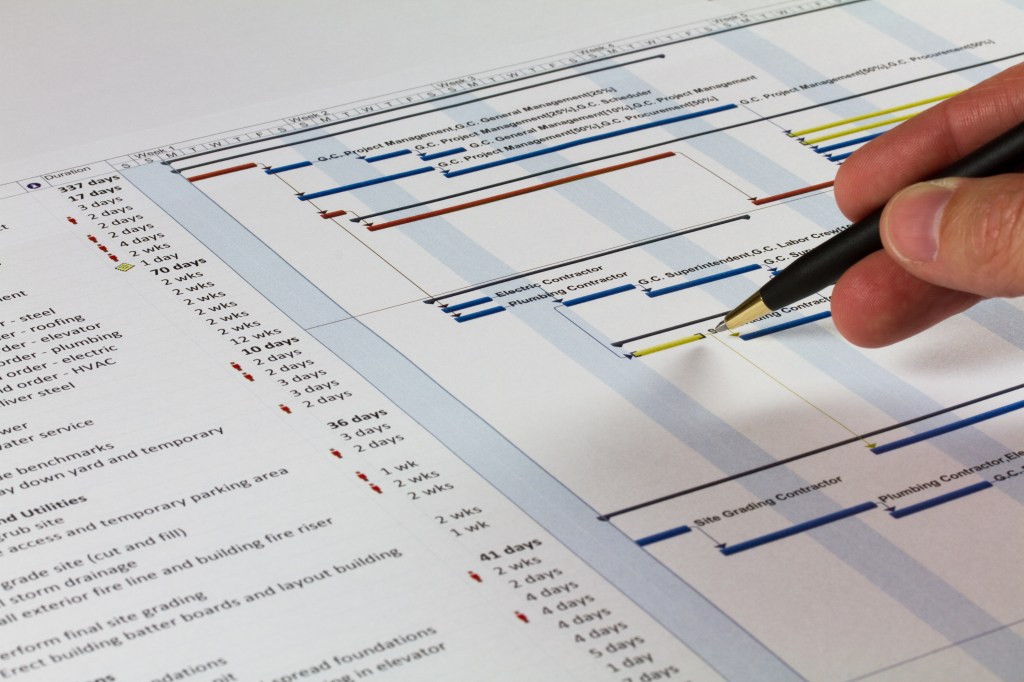Managing complex projects can be challenging for small businesses. A Gantt chart can help you to visualise how a project is progressing and identify any blockers.
But how do Gantt charts work and how do you create one? Read our guide for some top tips, as well as an overview of the pros and cons of using a Gantt chart for your business projects.
What is a Gantt chart?
A Gantt chart shows the entirety of a business project in a bar chart, allowing the project manager to work out how long it should take to complete.
The Y (vertical) axis of the chart will be split into a bar for each of the project’s separate tasks. Meanwhile, the X (horizontal) axis will usually be split into weeks and days.
The position of a bar on the X axis will depend on when the task is due to start and its dependencies. The length of the bar will depend on how long the task is due to take and when it’s due to be completed.
Most project managers who use Gantt charts will shade the bar for each task depending on how much of it has been completed. For example, they’ll shade 50 per cent of a bar for a task that’s half done and fully shade a bar for a task that’s been completed.
What is a Gantt chart used for?
This type of chart helps project managers to track:
- all the separate tasks needed to complete the project
- which tasks depend on each other
- who owns each task
- the projected start and completion dates
This type of visualisation is particularly useful for seeing which uncompleted tasks are blocking a project’s progress. A Gantt chart can also be used to see what impact changing the budget or workload would have on a project’s estimated end date.

cheekywemonkey/stock.adobe.com
Project managers will often use Gantt chart milestones to keep stakeholders up to date with events that mark significant progress. For example, if a toy company is creating a new teddy bear, milestones that could be flagged on the Gantt chart include:
- when initial research such as a SWOT analysis and competitor analysis have been completed
- when the design has been signed off
- when the prototype has been completed
- when health and safety checks have been completed
- the end of the first manufacturing run
What does Gantt stand for?
It’s believed that this kind of project management chart originated in Poland in the 1890s. However, it was tweaked and made popular by American engineer Henry Gantt in the early 1900s.
Since then, Gantt charts have taken the engineer’s name and are used globally by project managers.
These charts were originally drawn out by hand, although these days they’re generally created using programs like Excel or project management software.
How to make a Gantt chart
When creating a Gantt chart, the first three things you need to do are:
- identify all the individual tasks needed to complete the project
- work out which tasks depend on each other
- estimate how long each task is likely to take
Once you have this information, you can pull together a project schedule that you can display as a Gantt chart.
You’ll need to fill out all the tasks down the Y axis and the timeframes for the project on the X axis. Make sure you list the tasks in chronological order from top to bottom – the final individual task of the project should be at the bottom and furthest right position of the chart.
Before the project starts, it’s important that you allocate resources and budget so everyone is clear on what they need to do, how much it should cost, and how long it should take.
As the project progresses, you’ll need to:
- stay on top of communications – this can help you to fix problems and make sure that the project continues to run smoothly and on schedule
- provide updates and mark milestones – you’ll need to keep the chart up to date and send out updates when key tasks are completed
- identify and report problems – due to the visual nature of a Gantt chart, it’s easy to see when a task is overdue and the impact this could have on the wider project
Use a Gantt chart template
If you’re new to using this type of project management tool, a Gantt chart template can help you to get started.
There are different types of templates available, including Trello Gantt charts, as well as templates on Word and Excel.
Here are three free Gantt chart templates using these different formats:
- Excel template and tutorial from TeamGantt
- Word template from Office Timeline
- Trello power up from TeamGantt

Kaspars Grinvalds/stock.adobe.com
What are the Gantt chart advantages and disadvantages?
Gantt charts aren’t suitable for all types of projects, so it’s important to weigh up the pros and cons before deciding to use one.
Gantt chart advantages
A Gantt chart’s main advantage is that it provides a visual representation of a project, making it quick and easy to tell whether it’s on schedule.
Here are some more benefits of using a Gantt chart:
- having all tasks in one central place can help the project manager get a sense of the scale of a project and monitor its progress
- by listing tasks based on their dependencies, it’s easy to spot where a project is being slowed down and when a new task can start as another one finishes
- a digital Gantt chart can be adjusted quickly and can be shared easily among stakeholders
Disadvantages of a Gantt chart
But what are some of the downsides of using a Gantt chart?
- they can become complicated and messy if there are too many tasks and dependencies
- although it’s clear who’s responsible for what, Gantt charts don’t usually show the priority of each task
- using a basic time measurement makes it hard to know how much effort it takes to complete a task, which can make it difficult to plan resources for future projects
Do you have any unanswered questions about creating a Gantt chart? Let us know in the comments below.
Ready to set up your cover?
As one of the UK’s biggest business insurance providers, we specialise in public liability insurance and protect more trades than anybody else. Why not take a look now and build a quick, tailored quote?
NicoElNino/stock.adobe.com
NicoElNino/stock.adobe.com
